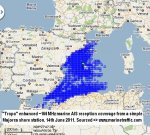Thanks Folks, and Good Morning from a sunny UK.
I'm pleased with progress so far, with a simple PICAXE solution in sight.
I've included the BTIMER.BAS program below, as someone asked for it.
I'm currently testing on an old PICAXE 08M Proto board, and will soon be testing on PICAXE 08M Servo Driver
(AXE024) to confirm it behaves the same way.
Tests yesterday, until I checked at 0800 this morning look encouraging:
about 1 second gain every hour, in room temperature of about 20C+/-2C.
i.e. It was about 10 seconds fast after starting at 2200 last night.
I will adjust the number in "pause 26900" below to try and get better accuracy
- for the expected temperature of the Solent sea water in July.
Yes, temperature is the main influence on stability in timing:
I stuck the working system in my boiler cupboard, with the digital thermomenter,
and the 35C made it gain 2 secs in just 20 minutes. i.e. 6 secs per hour.
Later in day I saw the posting by SRNET in which he gave his data - many thanks.
Luckily, for this "GPS bottle in sea" application, we can exploit the stability
of the sea water temperature, and locate the PICAXE low in the bottle, to keep
it's temperature as stable as possible. I'll soon be doing tests here, with
a prototype bottle in our pool out back, or a bowl of water kept at Solent temperature.
The Net should give me a first guess at Solent sea temperature, and I'm sure
a friend there can stick a thermometer in the water for me this week

I found far less variation in timing due to PICAXE supply voltage:
No noticible change (of 1 second) over typical at least an hour,
trying 5.5v (from Mallory cells) or the NiCads used which varied
between 4.18v and 5.47v when fully charged.
I'm relaxed about supply voltage because, in my solution, the 5v NiMHd PICAXE
supply will be trickle charged from the main 10v supply used for the tracker.
Probably a little flashing LED or two. I'm close to wiring this up and putting
outside for 24 hour testing, so I will see the variation in voltages and timing
through night and day - a few of which may also be sunny.
I'm also pleased that I've not yet used up my self-imposed 4 hour budget of time for this
part of the hobby project.
In fact, I'd even be interested to hear if anyone has simple, detailed instructions
on how to add a crystal based solution to what I already have, to make it more accurate.
If the instructions are precise enough, it may be worth my giving it a try.
Hopefully at least one of you have done it before.
Many Thanks to all of you.
Robin
www.gpss.co.uk/bottle.htm
p.s. I see Manuka is in Wellington,NZ. Let me check my links pages ...
... 8 guys, of the 10,561 in 165 countries - but for many it was years ago.
I'd need your street address or lat/lon to see if one is within walking distance
- not something for this Forum of course

Code:
'Moves servo 1 for 2 minutes every 19 minutes.
'This servo will be replaced by a servo switch to switch on and off GPS tracker.
servo 1,100 : servo 2,100 : servo 4,100 'initiate 3 servos
pause 1000 'pause 1 secs
w1=18 'counter for minutes until switch on
w2=2 'counter for minutes until switch off
gosub swon 'start with switch ON
top1:
gosub wait1m 'wiggle servos 2 and 4 every 60 seconds
w2=w2-1
if w2>0 then goto top1
gosub swoff 'swich OFF after 2 minutes
w2=2
top2:
gosub wait1m 'wiggle servos 2 and 4 every 60 seconds
w1=w1-1
if w1>0 then goto top2
gosub swon 'swich ON after 18 minutes
w1=18
goto top1
wait1m:
servopos 2,200 : servopos 4,200 'move two servos one way
pause 1000 'pause 1 sec
servopos 2,100 : servopos 4,100 'then move back
pause 30000 '30 secons delay - approx ?
pause 26900 'found by experiment to make up to exact 60 seconds
return
swoff:
servopos 1,100
return
swon:
servopos 1,200
return
Good luck-perhaps at least trial "bottling" a cheap smart phone? Android GPS tracking apps. now abound!
FWIW I'm up with the channel geography (& once lived coastal Sussex), but "5 miles offshore Ramsgate" is almost stone throwing distance here! NZ's nearest neighbour (Australia) is some 1300 miles away-in EU terms that's about London to Libya...

